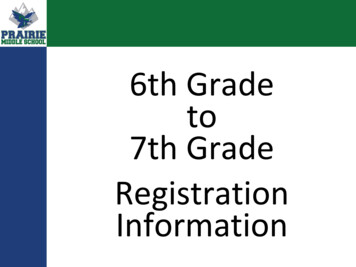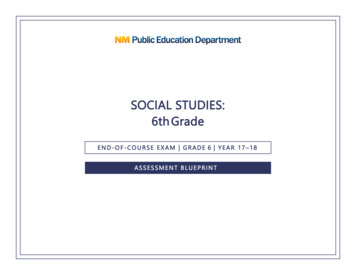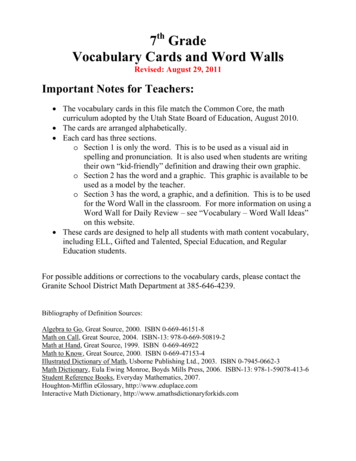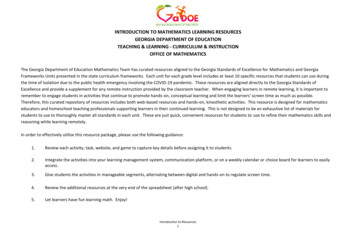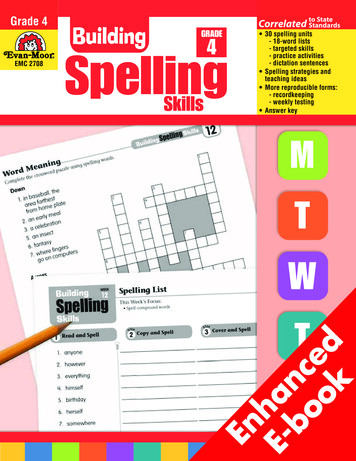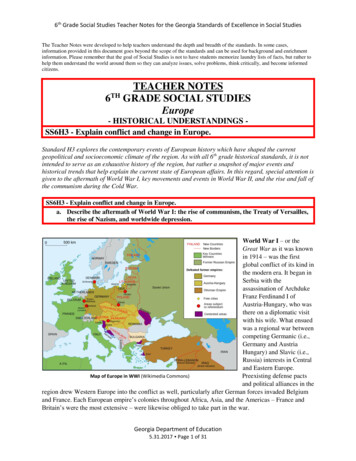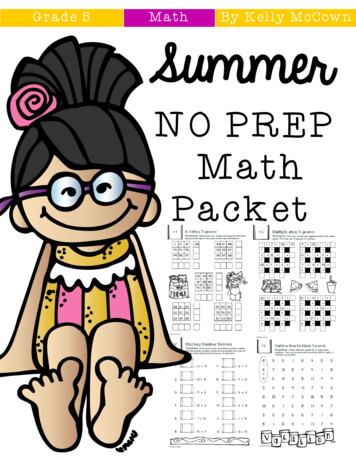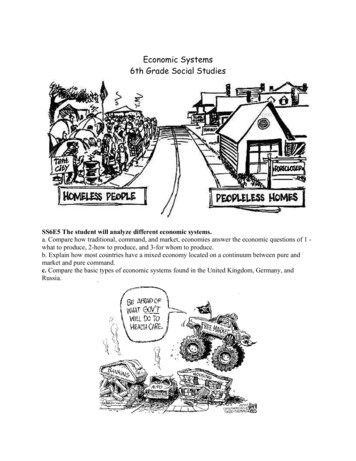
Transcription
Economic Systems6th Grade Social StudiesSS6E5 The student will analyze different economic systems.a. Compare how traditional, command, and market, economies answer the economic questions of 1 what to produce, 2-how to produce, and 3-for whom to produce.b. Explain how most countries have a mixed economy located on a continuum between pure andmarket and pure command.c. Compare the basic types of economic systems found in the United Kingdom, Germany, andRussia.
Name: Date: Class PeriodTypes of Economic Systems WorksheetThere are a few types of economic systems that exist in our world. But before we discuss them,we need to know what an economic system is. Basically, it is the process by which humans deal withscarcity (limited natural resources, time, money, water etc.). When confronted with this problem ofscarcity, humans must address three important questions in order to ensure that scarce resources areused properly. The three basic economic questions are as follows.3 Basic Economic Questions:1. What goods and services should beproduced?2. How should the goods be produced?3. Who should the goods be producedfor?4 Factors of Production:1. Land ‐ provides the natural resources.2. Labor ‐ provides the man power.3. Capital ‐ provides the equipment andtools.4. Entrepreneur ‐ the business personwho provides the idea.Directions: Using the questions above and notes below to complete the table and questions below.Explain how each economic system answers the 3 basic economic questions.Traditional System:A pure traditional economy answers thebasic economic questions according totradition. Things are done as they were in thepast based on tradition, customs and beliefs(religious). The customs and habits of the pastare used to decide what and how goods will beproduced, distributed, and consumed. Thismeans that in a traditional economy, things aredone how they have always been done (basedon tradition). In this system, members of thesociety know early in life what their role in thesociety will be. Since jobs are handed downfrom generation to generation (grandfather, tofather, to son), there is very little change in thesystem over generations. In a traditionaleconomy, people must fulfill their traditionalrole. If someone does not do his or her part, thesystem can easily break down. People intraditional economies usually are part offarming, hunting and gathering, or herdingsocieties, just like their ancestors. There are notraditional economies in Europe. The traditionaleconomies that exist today are in developingcountries (poor countries).Communist or Command System:The individual has little influence overhow the economic questions are answered in apure command system. The governmentcontrols the factors of production and makes allthe basic economic decisions. The governmenteven decides the role everyone will play. Itguides people into certain jobs.In a command economy, thegovernment determines which goods andserviced to produce, how much everything willbe sold for, and how much people will get paid.Individuals and corporations do not ownbusinesses or farms, instead businesses orfarms are owned by the government. Workersare told that they have a certain amount of timeto make a certain amount of goods. This is aquota. The government gives quotas to allworkers, and when every worker meets everyquota, then everyone in the country will havethe goods and services they need wheneverthey need them. When workers do not meettheir quotas, then shortages occur. A shortageis when there is not enough of something tosatisfy the needs of a country.The Soviet Union was an example of acommand economy. After the Soviet Unioncollapsed, Russia adopted a mixed economy.However, the government still owns and
Name: Date: Class Periodcontrols many large businesses and has a lot oflaws in place to limit private ownership ofbusinesses. Command economies are mostcommon in countries with a communistgovernment.Examples: North Korea, CubaMarket or Capitalist system:Capitalism is a pure market economy.In this system the government does not getinvolved. Individuals own the factors ofproduction and they decide the answers of thebasic economic questions. The market is thefreely chosen activities between buyers andsellers of goods and services. Decisions areguided by changes in prices that happenbetween buyers and sellers in the marketplace.Other names for market systems are freeenterprise, capitalism, and laissez‐faire. In amarket economy, individuals or corporationsgenerally own businesses and farms. Eachbusiness or farm decides what it wants toproduce. The law of supply and demanddetermines the price people pay for things.Supply is the amount of goods available anddemand is how many consumers want thegoods. Market economies are great forentrepreneurs because they get to haveeconomic freedom.Most of Europe has a somewherebetween a market and mixed economy,including the United Kingdom. The marketeconomy of the United Kingdom is consideredone of the most “free” economies in Europe.That means that businesses can operatewithout too many rules from the government.The rules from the government are only thereto protect the people, such as property rightsrules. People are able to start a businesswhenever they want and are able to do itquickly. Market economies are most commonin countries with a democratic government.Examples: the underground economy, 19thcentury Britain.Mixed Economic System:Many economist doubt that "pure" economicsystems ever existed. A mixed economic systemcontains elements of the market and commandsystems, with elements of traditional as well.For example, there is some private ownership inthe People's Republic of China. Some privateownership also existed in the former SovietUnion. Examples: United States, most othernations.Characteristics of the United States' MixedEconomic System: Not all decisions are made byindividuals reacting to the market. Federal, state, and local governmentsmake laws to regulate some areas ofbusiness. Public and private sectors contribute tothe economy in varying proportions. Forexample, federal defense spending canboost the economy; the Postal Serviceis a quasi‐governmental corporation. Government steps in to handleinequities in the system. Manysocial/welfare programs were createdduring the 1930s (Great Depression). Traditional celebrations like Christmasaffect portions of the economy. In addition to privately fundededucation, government funded publicschools provide free education.
Name: Date: Class PeriodEconomic Systems Comparison ChartBased on the reading above, explain who (or what) addresses the following questions below for each economic system.TraditionalEconomyCommandEconomyMarket EconomyMixed EconomyWho/Whatdecides the 3basic economicquestions?How much controldoes thegovernment haveover the economyin this system?What is anexample of acountry with thiseconomic system?What type ofgovernment mightcountries with thiseconomic systemhave?Draw a picturethat representsthis economicsystem.Define:Supply ‐Questions:1. What are the 3 basic economicquestionsDemand ‐Quota ‐Shortage ‐2. List and explain the 4 factors ofproduction.
NAME: DATE : PERIOD:Use these country descriptions to complete the questions and the economic continuum on thefollowing pages.United KingdomIn the United Kingdom citizens answer the basiceconomic questions. Citizens own the factors ofproduction and prices of goods are set by supply anddemand. Like the United States, the United Kingdom islargely a service based economy but also has anextremely efficient agricultural sector. The private sectorproduces goods and services for domestic andinternational markets based on the market price system(supply and demand). Industries have much economicfreedom in the UK. However, there have been recentmoves for the government to partially control thebanking industry and substantially regulate otherindustries.RussiaThe Russian government is largely involved with manyaspects of the economy and must approve anyinvestment larger than 50 million rubles. Thegovernment makes large scale production decisions andcontrols a large portions of the energy and shippingindustry. Citizens control smaller industries and makethe production decisions for small industries. Thegovernment regulates the prices of some products whileother prices are set by supply and demand.CubaMost industries are controlled by the government and 75– 93% of the labor force is employed by the government.The government decides what to produce and how muchto produce. The government owns all the factors ofproduction and decides prices for goods and services.Like many centrally planned economies, Cuba’s staterun entities are inefficient and do not provide all thegoods and services desired by citizens. Because of theseinefficiencies, Cuba has a vibrant informal(underground) economy that is estimated at about 40%of the total economy.AustraliaAustralia's economy is dominated by its services sector,yet it is the agricultural and mining sectors that accountfor the bulk of Australia's exports. The government usedto heavily control most of Australia's industries.However, since the 1980s, Australia has made a lot ofchanges in its economy. It has transformed itself from ahighly protected and regulated market to an open,internationally competitive, export-oriented economy.The freedom to start, operate, and close a business isstrongly protected under Australia's regulatoryenvironment.GermanyIn Germany citizens own the most of the factors ofproduction and make most of the economic decisions.The economy is primarily export-based, focusing onmanufacturing and commodities. German businesses arelargely privately owned and independent. Thegovernment regulates the agriculture, energy, andcommunications industries and there are increasingamounts of government involvement in the financial(banking) sectors. Most prices are set by supply anddemand, but a few are controlled by the government.There is also still an issue with updating the EasternGerman economy to compete and operate on par withWestern Germany. Germany survives largely based ontheir exports, which are determined by global markets(supply and demand). Western Germany still transfersbillions of dollars to Eastern German states to helpmodernize and update factories and production lines.CanadaCanada is famous for its socialized medicine (freehealthcare). The government provides free healthcare toall Canadian citizens. The government also highlyregulates businesses that operate in the medical industry.Other Canadian industries are mostly privately ownedand citizens make most of the economic decisions.Canada allows a tremendous amount of direct foreigninvestment by American companies. Many Americancompanies have very large operations in Canada.BrazilSince 1996, many Brazilian industries have becomeprivatized (privately owned). There is competition, bothforeign and domestic, in most major industries. The twolargest banks in Brazil are government-owned. Theownership of the factors of production tends to be heldby a privileged class of a few very wealthy people, witha large number in the population living in poverty.United StatesIn the United States the citizens decide what to producebased on market forces (supply and demand).Citizens answer the basic economic questions and ownthe factors of production. Most businesses, farms, andfactories are owned by citizens. The government onlysteps in to protect the environment and consumers fromunscrupulous business practices. The government alsoprovides a number of social welfare programs and publicschools. Buyers and sellers determine price of goods andservices based on supply and demand. Private ownersproduce goods for domestic and international markets.
NAME: DATE : PERIOD:Group Members:1. United KingdomDescribe location on continuumExplain your reasoning2. GermanyDescribe location on continuumExplain your reasoning3. RussiaDescribe location on continuumExplain your reasoning4. AustraliaDescribe location on continuumExplain your reasoning5. CubaDescribe location on continuumExplain your reasoning6. BrazilDescribe location on continuumExplain your reasoning7. CanadaDescribe location on continuumExplain your reasoning8. United StatesDescribe Location on continuumExplain your reasoning
NAME: DATE : PERIOD:United d StatesPureCommandEconomyMixed EconomyPureMarketEconomy
Name: Date: Period:Comparing European EconomiesUnited Kingdom, Germany, and RussiaUnited KingdomEconomic SystemUK has a economic systemIt’s actually closer to a economy than any other EuropeancountryUK is strong; one of the world’s leading powersNatural ResourcesWhat’s available?Coal, , natural gas, iron ore, lead, zinc, , tin,limestone, salt, clay, chalk, gypsum, potash, silica sand, slate, landLand UseWhat percentage of the land is (capable of being )?What are the major products?Cereals, oilseed, potatoes, vegetables, cattle, sheep, poultry, & fishIndustriesWhat’s being in the ?Machine tools, electric power equipment, automation equipment, railroadequipment, , aircraft, motor vehicles, communications devices,metals, chemicals, coal, petroleum, paper, textiles, food processing, clothing, &other consumer goodsLiteracy RateWhat percentage of people over the age of 15 can read and write?How long are students required to stay in school?Unemployment RateWhat percentage of people do not have jobs?What percentage of people live in poverty?GDP ( ) 2.137 trillion (2007)GDP ‐‐What is the value of goods and services produced per person? 35,100 (2007)Economic ProblemsUnemploymentOver depletion of natural resources (pollution)Improving public services (which forces the country to raise taxes)
Name: Date: Period:Federal Republic of GermanyEconomic SystemGermany has a economic systemAfter in 1990, East Germany had to move away from aeconomic system and slowly towards a Mixed system.Germany’s economy is Europe’s and is the largest in the worldNatural ResourcesWhat’s available?Coal, lignite, , iron ore, copper, nickel, uranium, potash, salt,construction materials, , arable landLand UseWhat percentage of the land is (capable of being )?What are the major agricultural products?Potatoes, wheat, barley, sugar beets, fruit, cabbages, cattle, pigs, poultryIndustriesWhat’s being in the ?Among the world’s and mostproducers of iron, steel, coal, cement, chemicals, machinery, vehicles, machinetools, electronics, food & beverages, shipbuilding, & textilesLiteracy RateWhat percentage of people over the age of 15 can and ?How long are students required to stay in school?Unemployment RateWhat percentage of people do not have jobs?What percentage of people live in poverty?GDP ( ) 2.81 trillion (2007)GDP ‐‐What is the value of goods and services produced? 34,200 (2007)Economic ProblemsModernizing the former East German economy (annual transfers from west to east of. )The former East Germany’s decayed economy continues to be a on thecountryOver of (pollution)Improving public services (which forces the country to raise taxes)
Name: Date: Period:Russian FederationEconomic SystemRussia has aRussia’s economy has been moving from a economy andmore a economy since the fall of thein not there yet (Mixed)Natural ResourcesWhat’s available?Wide base including deposits of ,, coal, many , timber*Obstacles such as harsh climate, terrain, distance, & size Russia’sexploitation (use) of natural resourcesLand UseWhat percentage of the land is (capable of being )?7% ( over is a major for growing crops!)What are the major agricultural products?Grain, sugar beets, sunflower seed, vegetables, fruits, beef, milkIndustriesWhat’s being in the ?Coal, oil, gas, chemicals, metals, machines, aircrafts, space vehicles, shipbuilding,communication devices, tractors, construction equipment, medical & scientificinstruments, textilesLiteracy RateWhat percentage of people over the age of 15 can read and write?How long are students required to stay in school?Unemployment RateWhat percentage of people do not have jobs?What percentage of people live in poverty?GDP 2.08 trillion (2007)GDP Per Capita‐‐What is the value of goods and services produced per person? 14,700 (2007)Economic ProblemsNatural resources are to use because of the climate, size andfew riversMoving the former economy of the Soviet Union(where the government made all of the decisions), and letting the public have a greaterinfluence on the economyUnemployment
Name: Date: Period:United KingdomRussiaGermany
6th Grade Social Studies . SS6E5 The student will analyze different economic systems. a. Compare how traditional, command, and market, economies answer the economic questions of 1 - what to produce, 2-how to produce, and 3-for whom to produce. b. Explain how most countries have a mixed economy located on a continuum between pure and
